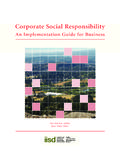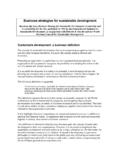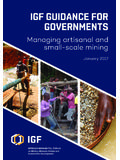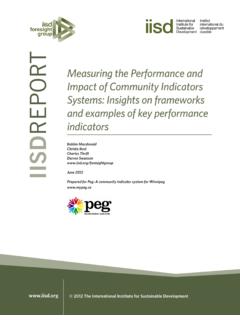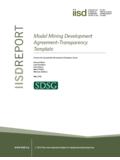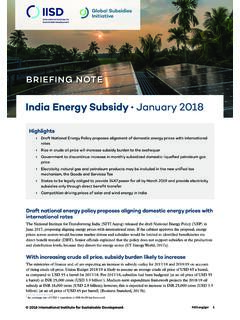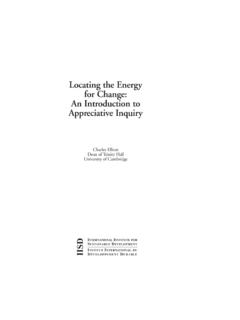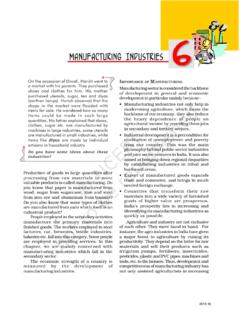Transcription of Global Market Report: Cotton - International Institute for ...
1 Demand for Cotton is expected to remain steady, despite stiff competition from synthetic fibres, though the effects of the current crisis due to COVID-19 might affect demand in the short to medium term. Cotton is the most widely used natural fibre in textiles, accounting for one third of total fibres manufactured Well known for its versatility, performance, and comfort, it can be used to create different types of fabrics that are strong, water absorbent, and Its uses go beyond textiles, however. The Cotton plant yields lint and seeds that are turned into fibre, edible oil, and animal More specifically, fibre is derived from Cotton lint, with 64% of fibre produced used in apparel, 28% used for home furnishings, and 8% for industrial Cotton seeds are crushed to obtain cholesterol-free oil, which is mainly used in cooking and as an ingredient in cosmetics, pharmaceuticals, and personal care products, along with other industrial applications, such as plastics and rubber.
2 Cotton seeds also produce a high-protein meal used to feed livestock and According to the World Wildlife Fund, Cotton is the most widespread profitable non-food crop in the world. 4 Cotton supports the Global textile mills Market and the Global apparel manufacturing Market that produces garments for wide use, which were valued at USD 748 billion and 786 billion, respectively, in Furthermore, Cotton supports a USD 3 trillion Global fashion industry, which includes clothes with unique designs from reputed brands, with Global clothing exports valued at USD trillion in ,5 Global Market report : CottonSUSTAINABLE COMMODITIES MARKETPLACE SERIES 2019 Vivek Voora, Cristina Larrea, and Steffany Bermudez Series Editor: Sofia Bali oCotton compliant with voluntary sustainability standards (VSSs) accounted for at least of total Cotton production in 1. Global Cotton production trend 2009 201614 Note: VSS-compliant production volumes refer to Cotton produced in compliance with one or more VSSs.
3 Conventional production volumes do not comply with any existing VSSs. Production volumes that are defined as potentially VSS-compliant cannot be definitively listed in either category with the data currently CompliantPotentiallyVSS CompliantConventionalMetric Tonnes17,000,00019,000,00021,000,00023,0 00,00025,000,00027,000,00029,000,0002009 2010201120122013201420152016 June 2020 Cotton represents the main source of livelihoods and revenue for up to 1 billion people, out of which 250 million work in Cotton processing and 100 million are farmers who cultivate Cotton . Approximately 90% of these farmers grow Cotton in less than 2 hectares (ha) of land and are located in developing countries, mainly in Central and West Asia, Southeast Asia, and Africa, including in 30 countries that are considered Low Human Development Countries (LHDCs) under the Human Development Index (HDI).
4 6 Cotton employs close to 7% of the entire labour force in developing Cotton is an export crop, but its processing takes place largely in the main producing countries, such as China and India, to obtain textiles and clothes. Over the past several years, there has been a Global shift in trading Cotton yarn and human-made fibres, rather than raw Cotton , to increase the value addition of domestic textile ,49 In 2017, over 30% of raw Cotton produced globally the equivalent of million tonnes was exported and was worth USD ,50 The largest exporting countries in 2017 for Cotton (raw Cotton , Cotton yarn, thread and woven fabrics: HS code 52) were China (USD billion), the United States (USD billion), and India (USD billion), while the largest importing countries in 2017 were China (USD billion), Bangladesh (USD billion), and Vietnam (USD billion).7,8 Looking at demand and supply dynamics for the commodity, Cotton demand at the spinning mill, where raw Cotton is transformed into yarn, outpaced supply from 2016 to 2018, resulting in a Global shortage during this period.
5 There was a Global Cotton deficit of approximately million tonnes in 2018, which led to a release of Cotton stocks that had accumulated in previous years, mainly by China, due to its policy to stockpile in order to influence Cotton A drop in Cotton supply in China, India, and the United States was due to adverse weather conditions, limited water availability, and pest This deficit is expected to continue until at least 2025, though it might be balanced slightly in the short term, depending on the extent of the impact of the COVID-19 crisis on Cotton Going forward, the potential continuation of China trade tensions and the Global economic downturn caused by the lockdowns to contain the spread of the novel coronavirus are two factors influencing the projected deficits in Cotton supply at the spinning ,11,52 The massive lockdowns during spring 2020 have impeded farm activity in India, one of the major Cotton producers, causing disruptions in the Cotton supply chain.
6 There is also a shortage of labour in Cotton plantations since millions of migrant workers had to flee to their villages. Cotton production in the country will be seriously affected since April and June are crucial months to begin sowing the summer rain-fed crops for the next These disruptions might influence projected deficits in the Cotton supply. Before the COVID-19 crisis, the Cotton sector was expected to grow steadily, driven primarily by the demands of the textiles and apparel sector,2 with this demand highly concentrated in the Asia Pacific In 2017, this region accounted for 61% and of the Global apparel manufacturing and retail Market value, respectively, followed by Europe. However, these industries are very sensitive to population and economic growth, which affects the ultimate demand for Prior to the COVID-19 crisis, economists projected the moderate growth of the Cotton sector, due to several supply-and-demand-related On the demand side, the fierce retail competition from more affordable synthetic fibres was a factor, especially in developing countries that drive the per capita How many tonnes of Cotton are certified by each standard?
7 Figure 2. VSS-compliant Cotton production volumes in 201622 Better Cotton Initiative (BCI) 2,942,000 tonnes Cotton made in Africa (CmiA) 320,100 tonnes Organic 107,980 tonnesFairtrade International 42,344 tonnesconsumption of textile fibres and where main population growth is expected. Another factor is the potential impacts of stock reductions on raising Cotton ,56 However, the current United States China trade war has fuelled uncertainty over the level and stability of Global Cotton demand, since the United States is a major importing country of textiles and apparel products coming from China. Moreover, recent estimates of Global Cotton demand have been revised downward as a result of measures implemented to mitigate the health effects of On the supply side, there are several factors that might reduce Cotton production levels, in turn influencing the growth of the overall sector.
8 As China and the United States have experienced in the last decade, the competition for growing more lucrative crops in producing countries reduces the land area for cultivating Cotton and leads to recurrent stagnant Despite potential agricultural land constraints on the sector that might affect supply levels, there are significant opportunities to improve yields via better agricultural practices and technological For instance, research shows that average Global yields have increased by almost 100% in the last 30 years due to these two factors, going from 411 kg/ha in 1980/81 to 790 kg/ha of Cotton lint in 2013 The ultimate impacts of the COVID-19 outbreak on the Cotton and textiles industry are still uncertain. However, the pandemic has already affected every link in the Cotton textile Global supply chain. Many factories and businesses have closed due to public health directives, which has led to cancellations and the suspension of existing orders by many Western clothing brands.
9 This, in turn, is expected to damage Cotton plantations and textile factories from countries such as Bangladesh and ,59,60 The research in this report was largely conducted in a pre-COVID context, though its insights into the Cotton sector and its prospects can contribute to planning in the post-COVID the situation stabilizes after the current lockdowns, demand for Cotton lint will be driven primarily by Chinese spinning mills, as China remains the largest producer, consumer, and trader of textiles and clothing in the world. 51 Indian mills are the second-largest source of demand, though there are signs of rapidly growing demand from spinning operations in Bangladesh, Indonesia, and The demand growth in those latter three countries is likely to be fuelled by their lower labour costs and import tariffs, as well as less demanding environmental regulations than ,13,51 For similar reasons, Chinese and Indian textile factories have also started to move their operations to African countries, a trend that might increase in the near Pre-COVID estimates suggested that Cotton prices were expected to be lower relative to 2015 and fairly stable until 2027, due to government interventions in Cotton -producing countries to ensure the crop s competitiveness versus synthetic The continuation of United States China trade tensions might keep the pressure on prices in the medium term.
10 Especially given concerns over the long-term viability of the phase one trade agreement signed between Beijing and Washington in early ,83 In March 2020, Cotton futures prices hit a 10-year low, as preventive measures to contain the spread of COVID-19 forced textile manufacturing companies to close and clothing retailers to shutter their increased adoption of VSSs by Cotton producers is another notable development in the Cotton Market over the past decade. In 2016, of the Market was made up of VSS-compliant Cotton , while accounting for only 1% in 2009. Meanwhile, Cotton that was potentially VSS-compliant represented of the Market . By comparison, conventional Cotton production accounted for of the Market , showing that there may still be significant room for growth in VSS social and environmental issues affect the sustainability of the Cotton Market advisory firm Mordor Intelligence predicts that Global Cotton consumption will experience a compound annual growth rate (CAGR) from 2019 to 2024, indicating moderate growth of the sector as mentioned above, though again not accounting for the COVID-19 This projection takes into consideration Cotton pricing estimates, which are influenced by Cotton stockpiling, mainly by China,84 as well as subsidies, trade agreements concerning Cotton , and Global production forecasts.
